More coffee, less caffeine: Intel 9th Gen (Part 1)
- Transfer
Part 1 → Part 2 → Part 3 → Part 4
The newest line of Intel desktop processors mainly includes changes aimed at performance enthusiasts. Intel has expanded consumer processors to eight cores, increased frequencies, improved heat transfer, and also updated hardware to better protect against Specter and Meltdown vulnerabilities. The only negative: will have to fork out and get a powerful cooler. This time, prices and power consumption have reached new limits.
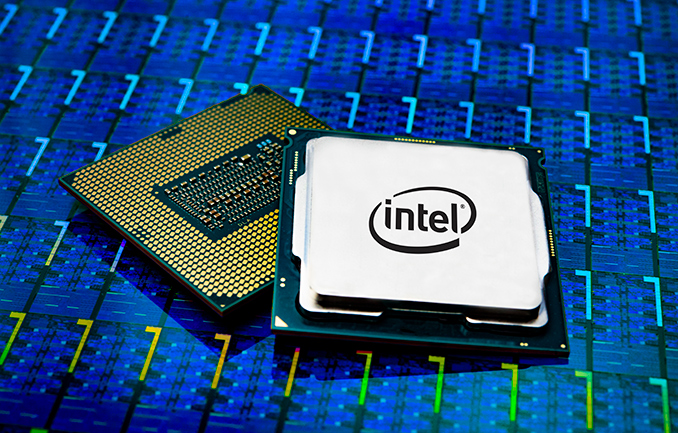
In the publication of the announcement of Intel, we elaborated on three new processors. Here is a brief reminder of the newest chip on the market. Currently, there are three processors: 8-core Core i9-9900K, capable of operating at a frequency of 5.0 GHz "out of the box", 8-core Core i7-9700K, which is slightly cheaper, and 6-core Core i5-9600K, which according to the specifications, it deserves the title of “market absorber”.
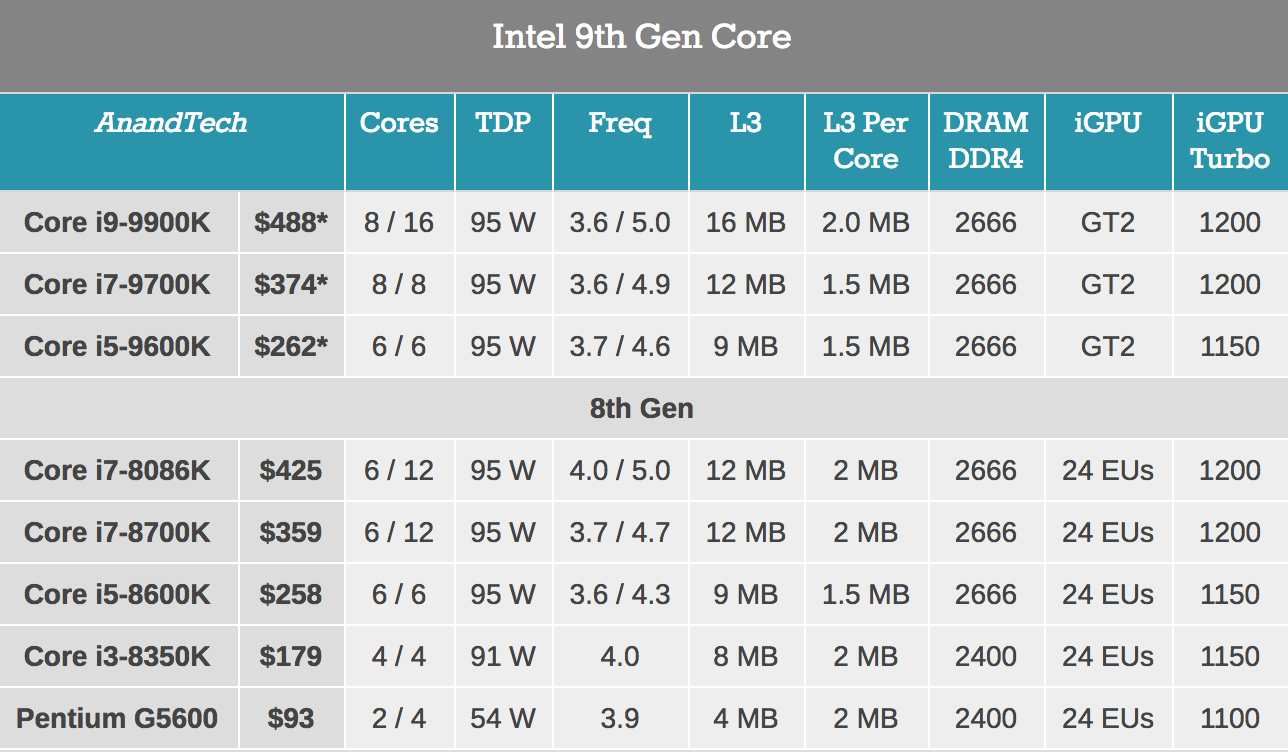
The new flagship is the Core i9-9900K, the world's first mainstream desktop processor carrying the name Core i9. This is an eight-core processor with sixteen threads, the first in the new line of Intel products. It offers a base frequency of 3.6 GHz and a maximum turbo frequency of 5.0 GHz, which actually turns out to be a dual-core turbo (we will demonstrate this fact below). In addition, the processor is ready for overclocking, which will allow users to overclock the frequency, provided sufficient cooling. And, although the memory controller is still officially designed for DDR4-2666, faster memory will work on virtually every chip. Plus, the Core i9-9900K has a fully-enabled cache with 2 MB per core, which generally gives 16 MB of cache. There is a built-in graphics, all the same UHD 630, as in the previous generation. All this comes at a retail price of $ 488, a cooler is not included.
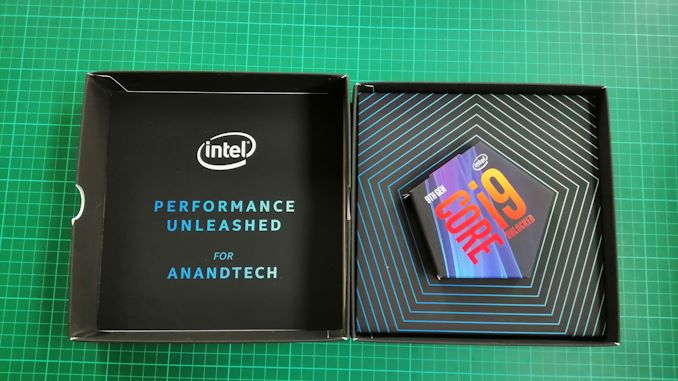
Core i7 now turned out to be a middling line, Core i7-9700K, in turn, looks magical. Intel did away with hyper-threading in this processor, providing only eight threads on eight cores, but with a base frequency of 3.6 GHz and a turbo frequency of 4.9 GHz. For the Core i7-9700K, Intel reduced the L3 cache to 1.5 MB per core, which may affect some software, but the processor is ready for overclocking and has support for DDR4-2666, like Core i9. The suggested retail price of $ 374 is a little easier to accept if the user is sure that two threads will never use the resources of one core. This chip will be interesting to compare with the latest generation Core i7-8700K processor. Core i7-8700K has two less cores, but uses hyper-threading.
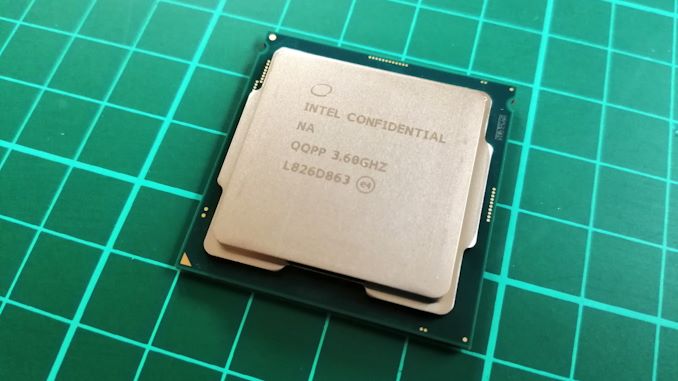
The Core i5-9600K looks like an “overclocking training” chip, the price is still $ 262, which is a few dollars more than the Core i5-8600K, in exchange for the additional frequency and all the additional features listed later in this article. The base frequency is 3.7 GHz and turbo frequency 4.6 GHz, there is support for DDR4-2666 and UHD 630 graphics.
All three parts are the first representatives of the Intel 9th Generation Core product line, and “under the hood” they hide an update to the Coffee Lake architecture, which was used in the products of the 8th generation Core. They are built on the Intel 14 ++ production site — the newest site that now defines high frequency and performance standards. The main aspects of the new lineup consisting of three processors, including their overall overclocking capability, stem from the internal changes made by Intel.
We were able to get the values of per-Core Turbo for each processor of the new line. Intel still classifies this information as “proprietary”, and therefore does not distribute it. However, Intel partners were happy to provide us with information, given the fact that it is still encoded in the system BIOS.

The big jump here is the 5.0 GHz turbo. In our review of the Core i7-8086K, where Intel had the opportunity to promote the chip as its first product with a clock frequency of 5.0 GHz, the fact that the value of 5.0 GHz was on one core was in fact a disadvantage - no matter As we tested the processor, there was enough load to work on more than one core, and in fact the user never sees the real 5.0 GHz. We only once managed to see how the core momentarily “flared” with the promised frequency, waiting at idle. Core i9-9900K now has two cores at a frequency of 5.0, which most likely means that we will still see this high frequency in our single-threaded testing.
For all that, it would seem, Intel decided to avoid hyper-threading on its new processors, the only Core processors that will receive simultaneous multithreading will be the Core i9 components and, possibly, the Pentium. This partly helps to make the product line more understandable, cheaper chips do not step on the heels of more expensive ones (for example, it is unlikely that a quad-core processor with simultaneous multi-threading can outperform a 6-core processor without). The other side is one of the recently discovered vulnerabilities to “third-party attack”, which occurs when hyper-threading is working. By turning off simultaneous multithreading on the chip line, Intel leveled this security issue. Now you can ensure that every thread on this chip does not compete for core resources.
One of the most interesting moments of the new products of the 9th generation is the separation of the L3 cache “by cores” in various models. In previous generations, the Core i7 processors had 2 MB of L3 cache per core, Core i5 had 1.5 MB of L3 cache per core, and Core i3 had a separation between some with 2 MB and 1.5 MB. At this time, Intel puts the full cache only on the top-end Core i9 components, reducing the Core i7 cache to 1.5 MB of L3 per core. It somehow affects the performance, which, when we get the processors, it will be interesting to test.
One of the topics that Intel has not paid serious attention to for several generations (in fact, since far times Broadwell) is the integrated graphics. All chips introduced in the 9th generation family will still have the same GT2 configuration as the 8th generation, including the new Core i9 processors. Officially, they fall under the designation 8+ 2. Intel still believes that having integrated graphics on these high-performance, overclocked processors is a valuable addition to the platform. The only drawback is performance, and in the near future it will remain at a low level.
Graphics will continue to be referred to as UHD Graphics 630 and use the same drivers as the 8th generation family.
The Intel 9th Generation Core processor family is built on the Coffee Lake platform, and since the processors do not have any micro-architectural changes, they are an upgrade of the 8th generation products, but with a slight change in the lineup. For those who followed the development of Intel processors, Coffee Lake was a remake of Kaby Lake (in turn, Skylake update). So, we are in the update update update update. What is essentially the same micro-architecture of 2015, which is again produced in 2018 (and will be made further).
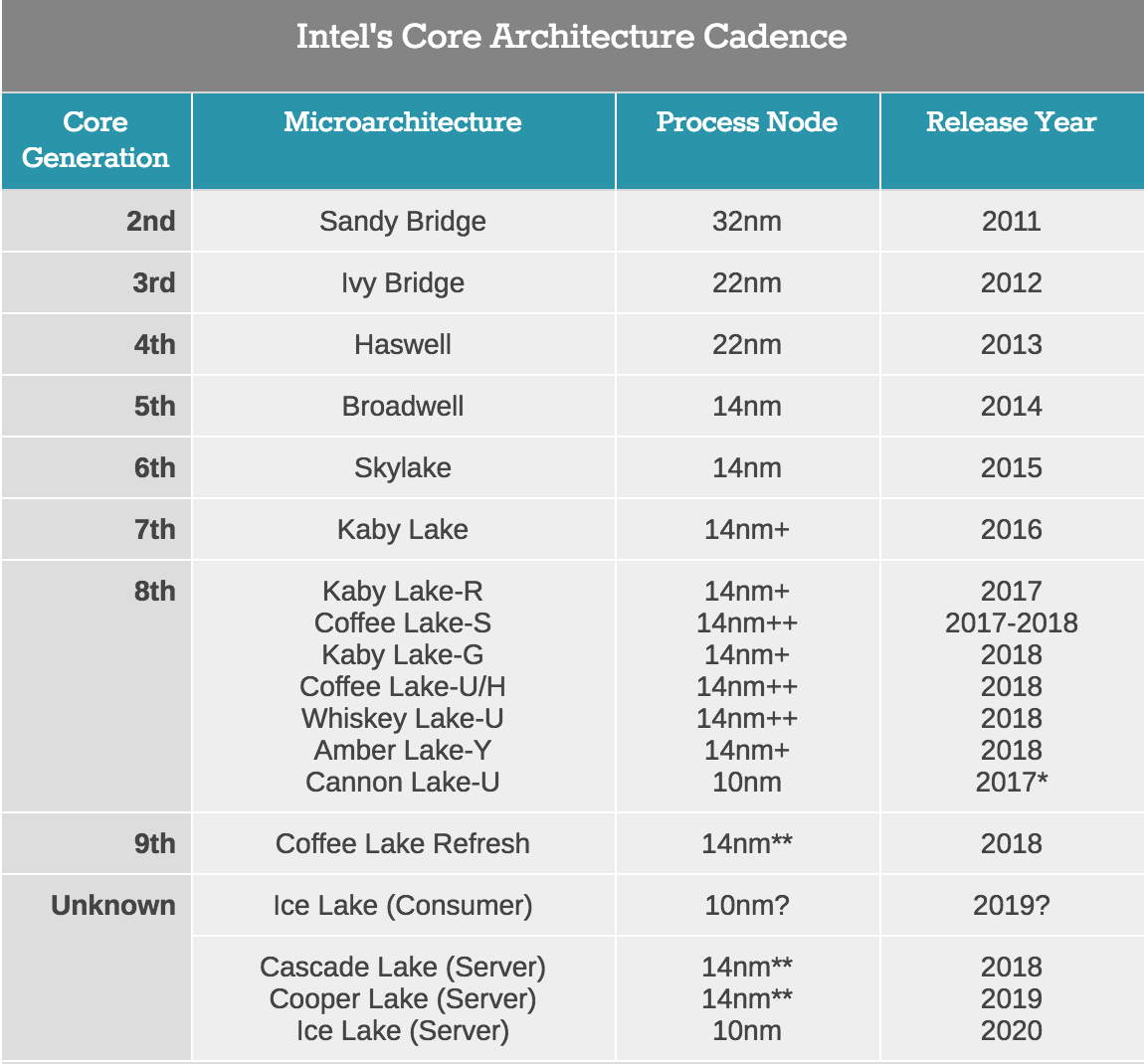
Intel promised that its 10nm manufacturing process will evolve until 2019, and has already announced that it will introduce Ice Lake for 10nm servers in 2020, after another 14nm release with Cooper Lake in 2019. From the point of view of consumers, the status remains uncertain - in any case, the next generation of consumer processors should be a proper upgrade of the micro-architecture, regardless of the nanometers of the process node.
No matter how we looked at the line of “consumer” processors, technically for a number of years, 8-core Intel processors have always been at the top of the stack. The Core i7-5960X was released in August 2014 and was equipped with eight Haswell cores on the HEDT platform with four-channel DDR4-2133 memory and 44 140-watt PCIe slots. Then, according to Intel's 22-nm process technology, the matrix size was about 355.52 mm2.
When Intel launched the first Coffee Lake processors, the 6 + 2 model for the i7-8700K was about ~ 151 mm2, which is 26 mm2 more than the 4 + 2 i7-7700K (~ 125 mm2) design. At that time, it was a jump from the official Intel 14+ to 14 ++ production site, which, due to the height of the edge, made the processors a bit more.
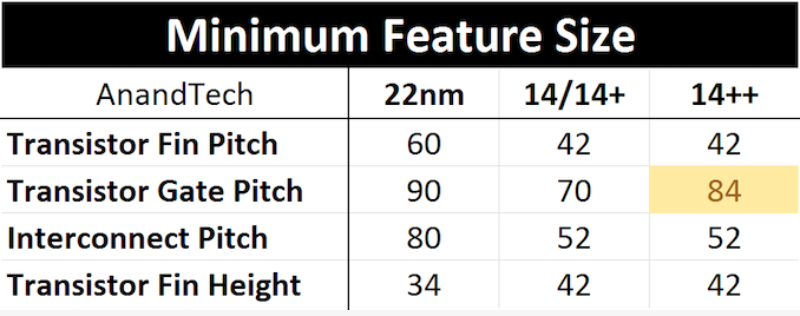
But if we take 26 mm2 as the limit of the increase in the size of the matrix when adding a pair of cores, we can predict that the size of 8 + 2 Core i9-9900K should be about 177 mm2 or 17% more. At 177mm2, including integrated graphics, this will be half the size of the Core i7-5960X, albeit with half as many memory controllers and PCIe lanes. But, in any case, this is a significant decrease.
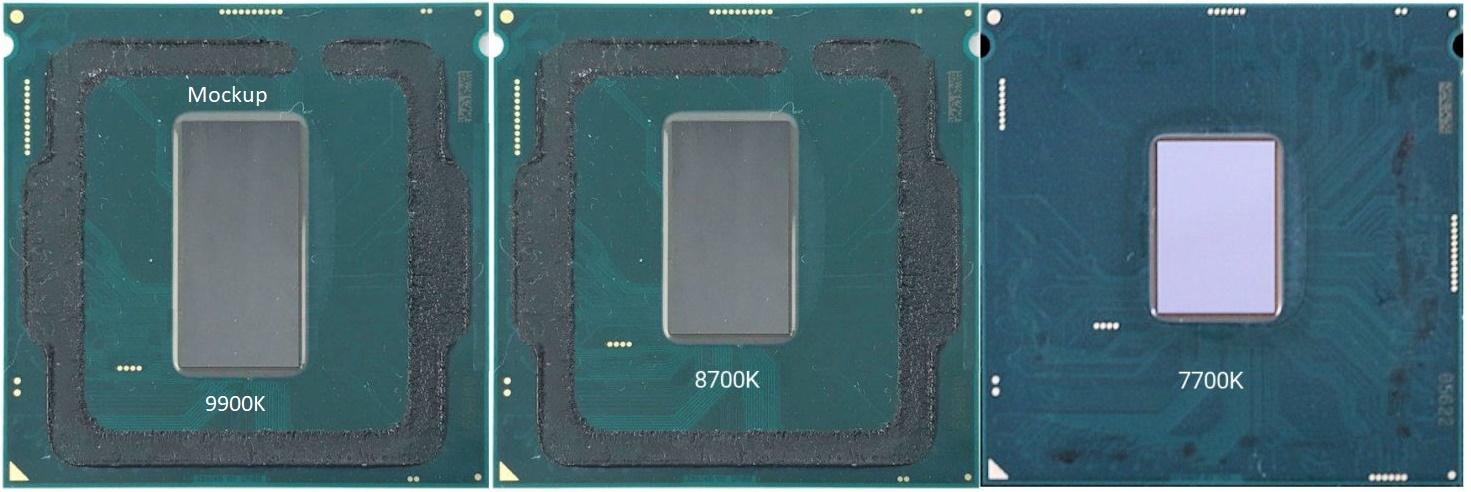
It can be assumed that a 17% increase in crystal area can directly mean a 17% price increase. In this case, with a 17 percent increase in the price of the Core i7-8700K, we would get a price of $ 420, while the official price is $ 488 for a K-equivalent processor. Given the pricing policy of Intel (one chip can be sold twice cheaper than the other), it is difficult to say how much this 488 dollars increase the profitability of the product for the company.
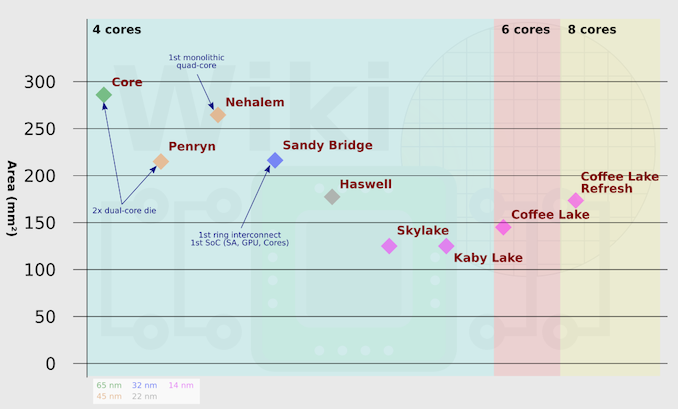
If we look at the size of the top-level chips, over the decade of the quad-core processors, the crystal size has steadily decreased, starting with the Nehalem quad-core core with an area of more than 260 mm2, up to Kaby Lake by 125 mm2. Currently, it is steadily increasing as more and more nuclei are being added. It is terrible to think that Intel will happily spend 260 + mm2 on the mainstream silicon matrix today in its latest manufacturing process.
Specter and Meltdown's vulnerabilities made noise at the beginning of this year, forcing hardware and software developers to release updates to close security holes. There are several ways to troubleshoot problems, including software, hardware firmware and hardware updates. Each generation of products slowly introduces patches, including new 9th generation processors.
At the moment, Intel has divided the list into 5-6 broad variants of various types of vulnerabilities. For all processors of the second half of 2018, the following table looks like this: The
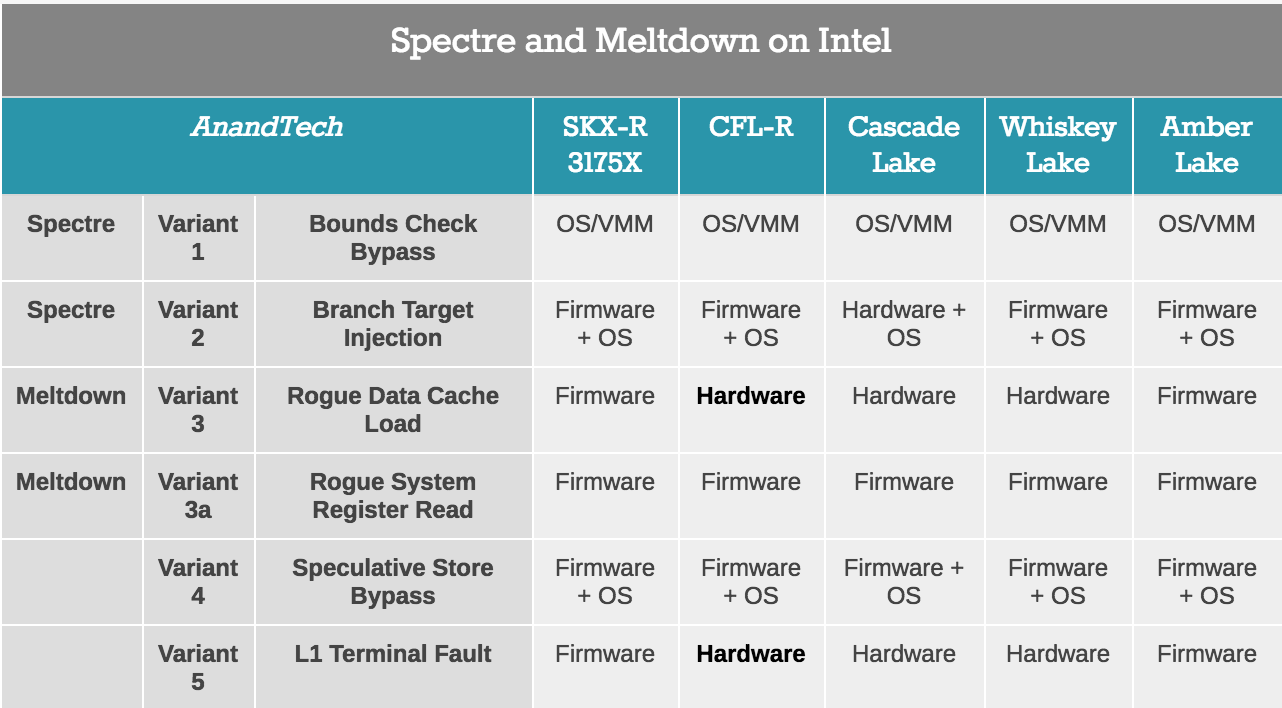
new 9th generation processors mentioned in the CFL-R view (Coffee Lake Refresh) implemented hardware fixes for option 3, Rogue Data Cache Load and option 5, L1 Terminal Fault.
Since the new chips required new templates for production, Intel was able to make these changes. Moving changes to the hardware part means that the hardware is always protected, regardless of the OS or environment. Any additional software patch overhead can be reduced if fixes are applied at the hardware level.
As for the desktop processors that we use today, they consist of a silicon matrix, a substrate (green), a heat sink (silver), and a material that helps to transfer heat from the silicon matrix to the heat sink. The quality of the binding of a silicon matrix to a heat sink using a thermal interface material is a key component in the ability of processors to remove heat generated from its use.
Traditionally, there are two different types of heat transfer material: thermal grease or metal spike. Both have positive and negative sides.

Thermally conductive paste is a versatile tool - it can be applied to almost any manufactured processor and can be used in a wide range of changing conditions. Since metals expand when heated while the processor is running, it expands - as well as the heat sink. Pasta easily copes with this. This allows paste-based processors to "live" longer in different environments. The use of a bonded metal usually reduces the number of thermal cycles, since the metal expands and contracts differently than a liquid. This may mean that the processors "on soldering" have an estimated lifespan of several years, in contrast to the potential decades of work on thermal paste. However, heat transfer soldered metal performs much, much better than a paste based on silicon. True,

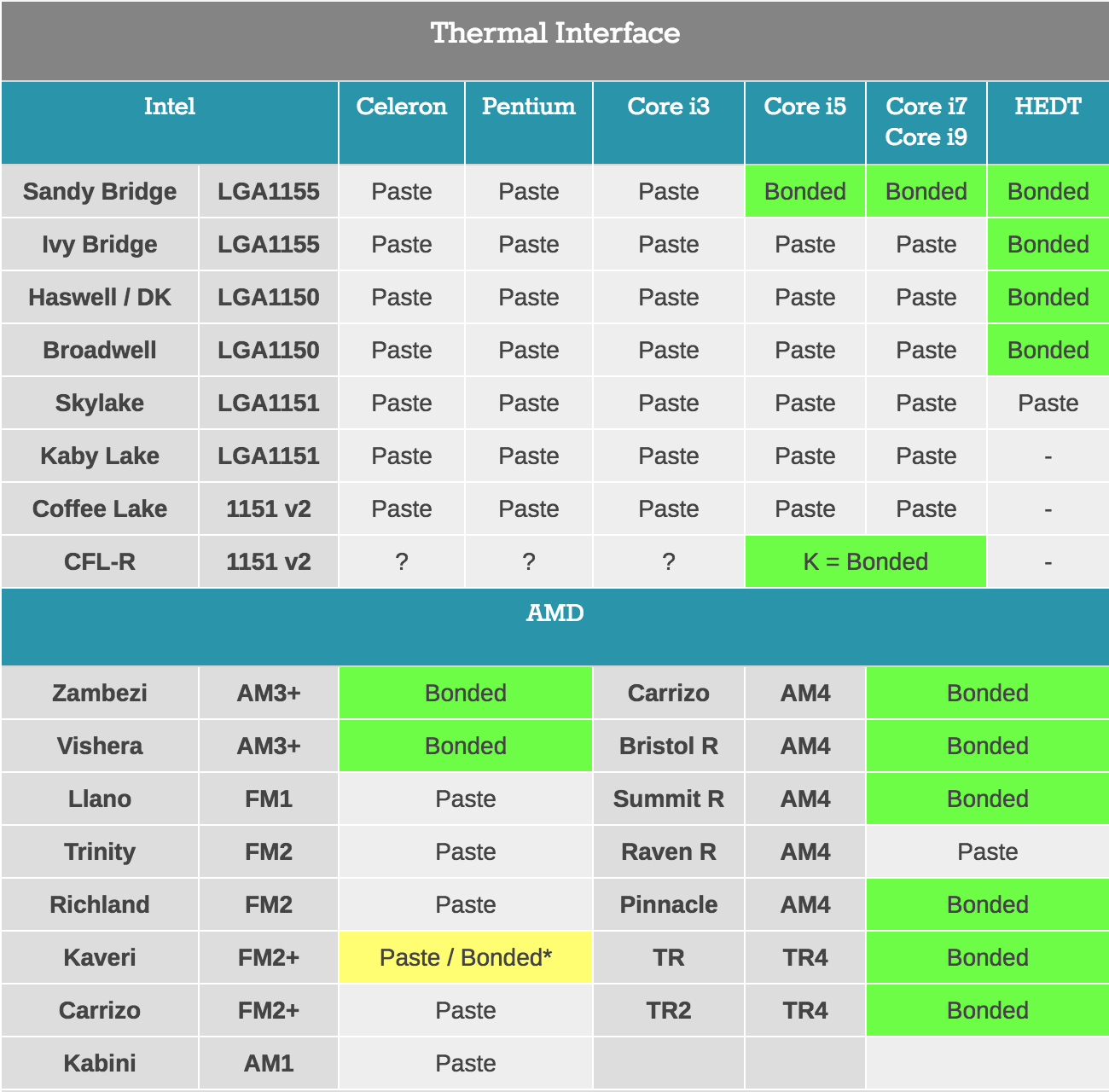
In our article on the scalping of the Ryzen APU, we looked at the process of removing the heat exchanger and conductive paste from a popular low-cost product, and showed that replacing the paste with a bound metal improves temperature, overclocking and performance when accelerating to an average level. If a company wants to make productivity enthusiasts happy, using metal for heat transfer is a good choice.
For several years, Intel has declared that they work for enthusiasts. In the distant past, as shown in the table above, Intel used a brazed metal thermal interface in the processors, and this suited everyone. Recently, however, the entire product line has been transferred to heat transfer paste for a number of reasons.
Since Intel has consistently said that they still care about performance enthusiasts, many users have begun to feel that the company is confused. Some believed that Intel divided the "enthusiasts" and "overclockers" into two different non-overlapping categories. We have what we have, but now Intel has returned to the use of STIM and wants to compete again for the attention of overclockers.
Intel has officially confirmed that the new 9th generation processors will be equipped with a welded metal heat transfer interface, providing TIM between the matrix and the IHS. New soldering processors include the Core i9-9900K, Core i7-9700K and Core i5-9600K.
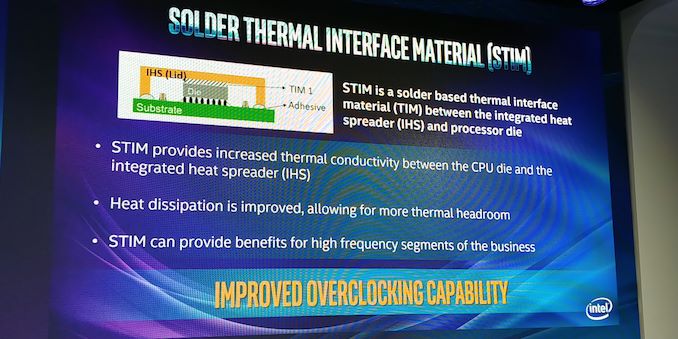
As we show in this review, the combination of STIM and other functions is of great help in overclocking new processors to the upper limits. Intel’s own overclocking team at the launch event reached 6.9 GHz, temporarily using exotic supercoolers such as liquid nitrogen.
This year, the Intel Z390 chipset from Intel has become one of the most hidden secrets. If you believe everything that motherboard manufacturers have told me, most of them have been ready for release in just a few months, and therefore about 55 new motherboards will hit the market this month and next.
The Z390 chipset is a Z370 upgrade, and both types of motherboards will support 8000 and 9000 series processors (a BIOS update is required for the Z370). The updates are similar to the B360 updates: native USB 3.1 10 Gbps ports and integrated Wi-Fi on the chipset.
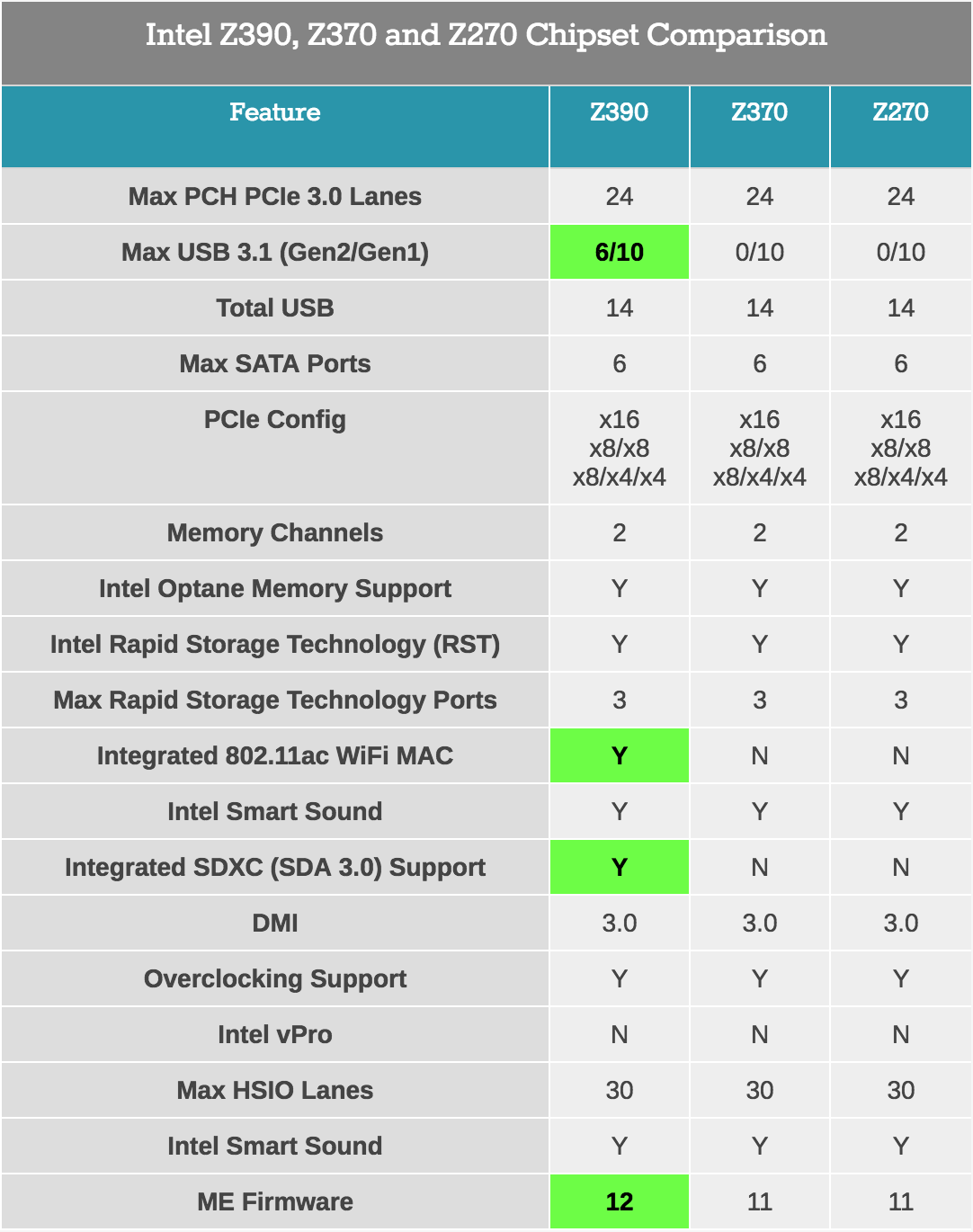
Integrated Wi-Fi uses CNVi, which allows the motherboard manufacturer to use one of the three accompanying Intel RF modules as a PHY, instead of using potentially more expensive MAC + PHY combinations from an external vendor (such as Broadcom). I was told that the cost of implementing CRF adds about $ 15 to the retail price of the motherboard, so we are likely to see that some vendors are experimenting with mid-range models without using Wi-Fi.
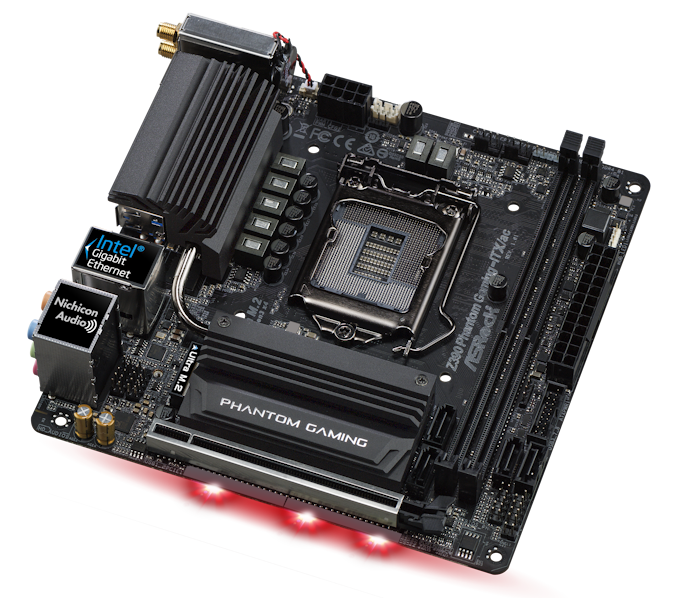
ASRock Z390 Phantom Gaming-ITX / ac
For USB 3.1 Gen 2 ports, Type-A ports are initially supported, and motherboard manufacturers will need to use re-driver chips to maintain Type-C compatibility. This will require additional money, as one would expect. It will be interesting to see how manufacturers mix and match Gen 2, Gen 1 and USB 2.0 ports on the back panels, now they have a choice. I suspect that this may affect the integrity of the signals in the motherboard tracks.

MSI MEG Z390 Godlike
For the Z390 chipset and motherboards, we have at our disposal our usual test bench covering every model that the manufacturers will tell about. Interestingly, even a mini-ITX with Thunderbolt 3 will be offered, and one board with a PLX chip! There are also some motherboards with a Realtek 2.5G Ethernet controller - it would be nice to have consumer-grade switches for them.
In accordance with our policy of testing the processor, we take a premium motherboard, with a suitable socket, and equip the system with enough memory that runs at the maximum frequency supported by the manufacturer. Testing is also performed, when possible, with JEDEC settings.
It is noted that some users dispute this approach, mentioning that sometimes the maximum supported frequency is rather low, or faster memory is available at a similar price, or that the use of supported frequencies may reduce performance. Although these comments make sense, in the end, very few consumers use memory profiles (XMP or others), as they require interaction with the BIOS, and most users refuse to support JEDEC speeds - this includes both home users and vendors who may want reduce the margin for a couple of cents or stay within the limits set by the manufacturer. Where possible, we will extend testing to add faster memory modules, either in this review or later.

We should thank the companies listed below for the kind equipment provided for our numerous test benches. Some of this hardware was not used in the tests used today, but used in other tests.

In order for testing to remain relevant, we have to constantly update the software. In updates, we usually introduce the latest operating system, the latest fixes, the latest software versions, the latest graphics drivers, as well as add new tests or remove old ones. As known to regular readers, our processor testing includes an automated test suite, and depending on how the latest software works, the test suite can be modified, updated, or deleted, or completely rewritten. The last time we did a full revision, it took most of the month, including regression testing (testing old processors).
One of the key elements of our update tests for the 2018 (and 2019) year is the fact that our scripts and systems are reworked taking into account the Specter and Meltdown vulnerabilities. This means that all our BIOSes are updated with the latest microcode, and all steps are performed by the operating system with security updates. In this case, we are using Windows 10 x64 Enterprise 1709 with April security updates that provide Smeltdown (our combined name) mitigation. Users may ask why we are not running Windows 10 x64 RS4, the last major update that does not delete your data — this is due to some new features that give uneven results. Instead of spending a few weeks researching to disable them, we’ll use the RS3 option,
Our previous test suite was divided into several segments depending on how the test should be perceived. Our new test suite fits similar parameters, and we run tests based on:
Depending on the focus of the review, the order of these benchmarks may change, or some of them may be omitted in the review. All results data will be in our online Bench database, which now has a new section “CPU 2019” for all our new tests.
In each section, we will conduct the following tests:
Our power tests are to run a significant workload for each thread in the system, and then examine the power registers on the chip to learn details, such as the power consumption of the cores, the entire chip, the power of the DRAM, the I / O and the individual core . It all depends on how much information the chip maker gives: sometimes a lot, and sometimes nothing.
We currently use POV-Ray as the main test, since it seems to affect the deepest of the system, and is very consistent. To limit the number of cores for testing, we use the mask entered from the command line.
These tests involve disabling all turbo modes in the system, forcing it to work at the base frequency, and then implement both the memory latency check (Intel Memory Latency Checker works equally well for both platforms) and AIDA64 to check the throughput of the cache.
We again decided to go back to using LinuxBench 1.0. This was in our 2016 test suite, but was dropped in 2017 because it added an extra level of complexity to our automation. Thanks to the requests of the readers, we will launch it again.
We are working hard at automating about a dozen games at four different levels of performance. Most games will provide data on the frame time, but because of the complexity of automation, not all. The idea is to get a set of various genres and test engines. So far we have managed to automate the following games:
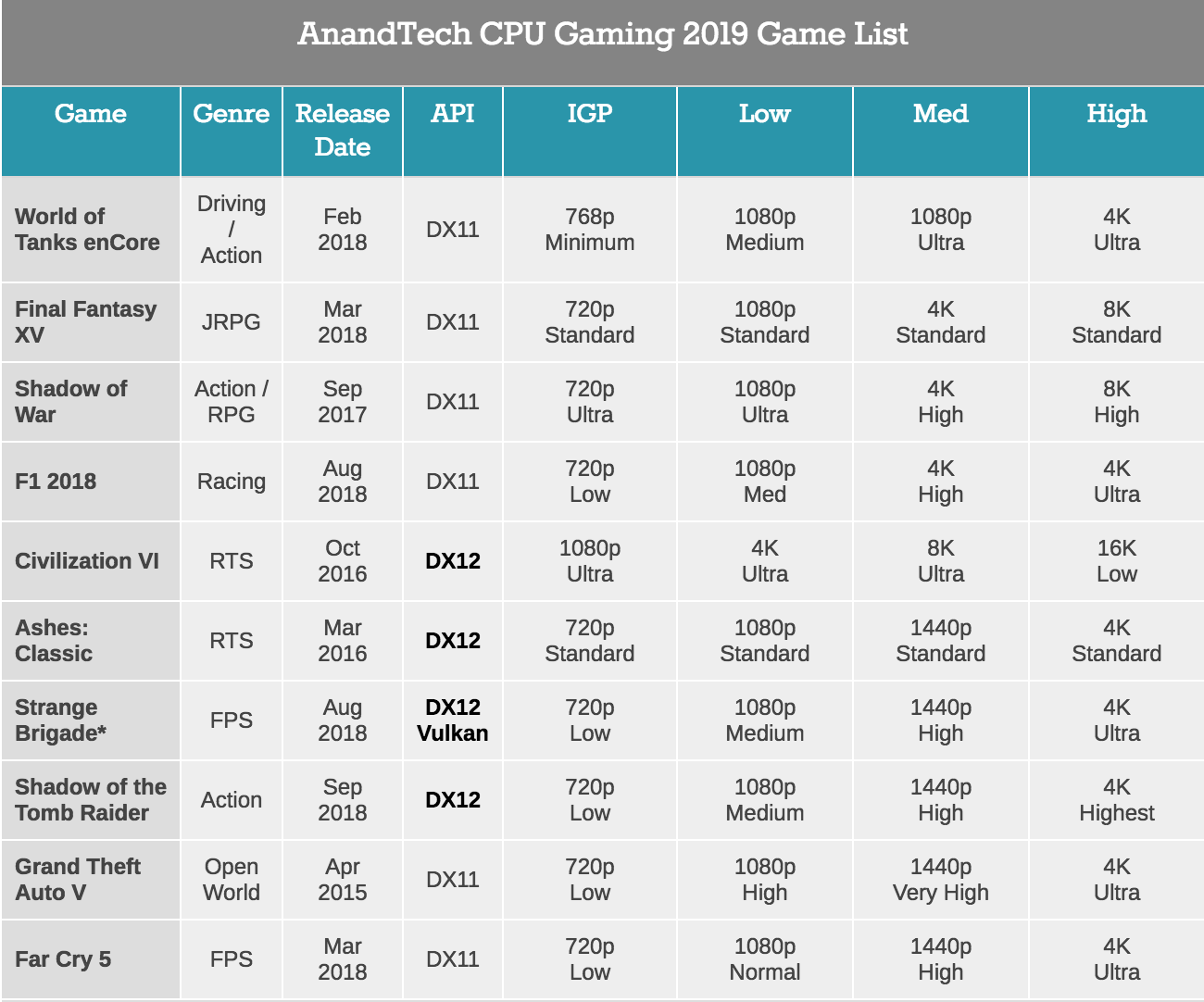
For CPU Gaming tests, we will work on NVIDIA GTX 1080. For pure CPU testing, we use the RX460, since we now have several devices for parallel testing.
In previous years, we tested various video cards on a small number of games, but this time, due to a Twitter survey that gave a result of exactly 50:50, we will do the opposite: more games, fewer graphics processors.
Day after day we get the same comment: automation is not the best way to test. There is a high barrier to entry, and it limits the tests that can be performed. From our point of view, despite the time spent on programming (plus the analysis of the results obtained), automation means that we can do several things:
Our test software compares all the results, and sends all the data of the running tests to the central repository, and I can analyze the data as it arrives. This also acts as a manual check in case any data looks abnormal.
We have one main limitation, it concerns our game tests. We run several tests through a single Steam account, and some games (for example, GTA) are only available online. Because Steam allows one account to run the game on only one system, our game script checks the Steam API to determine whether we are “online” or not, and runs offline tests if the account is allowed to log in. Depending on the number of games that absolutely require an online mode, this need may be a bottleneck.
As always, we fulfill requests to use benchmarks. This helps us understand the workloads that users work with and plan their testing accordingly.
Note on software packages: we had requests for tests for software such as ANSYS or other professional-level software. The downside to testing this software is licensing and scaling.
Most of these companies do not particularly care that we conduct tests, and state that this is not in their plans. Others, such as Agisoft, are more than willing to help. If you are a developer of these software packages, the best way to see how we use them is to give us a hand. We have special software versions for some tests, and if we can get something that works and is important for our audience, it will be easy for us to add it to the test suite.
Thank you for staying with us. Do you like our articles? Want to see more interesting materials? Support us by placing an order or recommending to your friends, a 30% discount for Habr users for a unique analogue of the entry-level servers that we invented for you:The whole truth about VPS (KVM) E5-2650 v4 (6 Cores) 10GB DDR4 240GB SSD 1Gbps from $ 20 or how to share the server? (Options are available with RAID1 and RAID10, up to 24 cores and up to 40GB DDR4).
VPS (KVM) E5-2650 v4 (6 Cores) 10GB DDR4 240GB SSD 1Gbps until January 1 for free if you pay for a period of six months, you can order here .
Dell R730xd 2 times cheaper? Only we have 2 x Intel Dodeca-Core Xeon E5-2650v4 128GB DDR4 6x480GB SSD 1Gbps 100 TV from $ 249 in the Netherlands and the USA! Read about How to build an infrastructure building. class c using servers Dell R730xd E5-2650 v4 worth 9000 euros for a penny?
The newest line of Intel desktop processors mainly includes changes aimed at performance enthusiasts. Intel has expanded consumer processors to eight cores, increased frequencies, improved heat transfer, and also updated hardware to better protect against Specter and Meltdown vulnerabilities. The only negative: will have to fork out and get a powerful cooler. This time, prices and power consumption have reached new limits.

Coffee Lake Update
In the publication of the announcement of Intel, we elaborated on three new processors. Here is a brief reminder of the newest chip on the market. Currently, there are three processors: 8-core Core i9-9900K, capable of operating at a frequency of 5.0 GHz "out of the box", 8-core Core i7-9700K, which is slightly cheaper, and 6-core Core i5-9600K, which according to the specifications, it deserves the title of “market absorber”.

The new flagship is the Core i9-9900K, the world's first mainstream desktop processor carrying the name Core i9. This is an eight-core processor with sixteen threads, the first in the new line of Intel products. It offers a base frequency of 3.6 GHz and a maximum turbo frequency of 5.0 GHz, which actually turns out to be a dual-core turbo (we will demonstrate this fact below). In addition, the processor is ready for overclocking, which will allow users to overclock the frequency, provided sufficient cooling. And, although the memory controller is still officially designed for DDR4-2666, faster memory will work on virtually every chip. Plus, the Core i9-9900K has a fully-enabled cache with 2 MB per core, which generally gives 16 MB of cache. There is a built-in graphics, all the same UHD 630, as in the previous generation. All this comes at a retail price of $ 488, a cooler is not included.

Core i7 now turned out to be a middling line, Core i7-9700K, in turn, looks magical. Intel did away with hyper-threading in this processor, providing only eight threads on eight cores, but with a base frequency of 3.6 GHz and a turbo frequency of 4.9 GHz. For the Core i7-9700K, Intel reduced the L3 cache to 1.5 MB per core, which may affect some software, but the processor is ready for overclocking and has support for DDR4-2666, like Core i9. The suggested retail price of $ 374 is a little easier to accept if the user is sure that two threads will never use the resources of one core. This chip will be interesting to compare with the latest generation Core i7-8700K processor. Core i7-8700K has two less cores, but uses hyper-threading.

The Core i5-9600K looks like an “overclocking training” chip, the price is still $ 262, which is a few dollars more than the Core i5-8600K, in exchange for the additional frequency and all the additional features listed later in this article. The base frequency is 3.7 GHz and turbo frequency 4.6 GHz, there is support for DDR4-2666 and UHD 630 graphics.
All three parts are the first representatives of the Intel 9th Generation Core product line, and “under the hood” they hide an update to the Coffee Lake architecture, which was used in the products of the 8th generation Core. They are built on the Intel 14 ++ production site — the newest site that now defines high frequency and performance standards. The main aspects of the new lineup consisting of three processors, including their overall overclocking capability, stem from the internal changes made by Intel.
Turbo of each core
We were able to get the values of per-Core Turbo for each processor of the new line. Intel still classifies this information as “proprietary”, and therefore does not distribute it. However, Intel partners were happy to provide us with information, given the fact that it is still encoded in the system BIOS.

The big jump here is the 5.0 GHz turbo. In our review of the Core i7-8086K, where Intel had the opportunity to promote the chip as its first product with a clock frequency of 5.0 GHz, the fact that the value of 5.0 GHz was on one core was in fact a disadvantage - no matter As we tested the processor, there was enough load to work on more than one core, and in fact the user never sees the real 5.0 GHz. We only once managed to see how the core momentarily “flared” with the promised frequency, waiting at idle. Core i9-9900K now has two cores at a frequency of 5.0, which most likely means that we will still see this high frequency in our single-threaded testing.
More coffee, less caffeine: Hyper-Threading and L3 Cache
For all that, it would seem, Intel decided to avoid hyper-threading on its new processors, the only Core processors that will receive simultaneous multithreading will be the Core i9 components and, possibly, the Pentium. This partly helps to make the product line more understandable, cheaper chips do not step on the heels of more expensive ones (for example, it is unlikely that a quad-core processor with simultaneous multi-threading can outperform a 6-core processor without). The other side is one of the recently discovered vulnerabilities to “third-party attack”, which occurs when hyper-threading is working. By turning off simultaneous multithreading on the chip line, Intel leveled this security issue. Now you can ensure that every thread on this chip does not compete for core resources.
One of the most interesting moments of the new products of the 9th generation is the separation of the L3 cache “by cores” in various models. In previous generations, the Core i7 processors had 2 MB of L3 cache per core, Core i5 had 1.5 MB of L3 cache per core, and Core i3 had a separation between some with 2 MB and 1.5 MB. At this time, Intel puts the full cache only on the top-end Core i9 components, reducing the Core i7 cache to 1.5 MB of L3 per core. It somehow affects the performance, which, when we get the processors, it will be interesting to test.
Integrated graphics
One of the topics that Intel has not paid serious attention to for several generations (in fact, since far times Broadwell) is the integrated graphics. All chips introduced in the 9th generation family will still have the same GT2 configuration as the 8th generation, including the new Core i9 processors. Officially, they fall under the designation 8+ 2. Intel still believes that having integrated graphics on these high-performance, overclocked processors is a valuable addition to the platform. The only drawback is performance, and in the near future it will remain at a low level.
Graphics will continue to be referred to as UHD Graphics 630 and use the same drivers as the 8th generation family.
Coffee Lake Refresh: lessons from GPU manufacturers
The Intel 9th Generation Core processor family is built on the Coffee Lake platform, and since the processors do not have any micro-architectural changes, they are an upgrade of the 8th generation products, but with a slight change in the lineup. For those who followed the development of Intel processors, Coffee Lake was a remake of Kaby Lake (in turn, Skylake update). So, we are in the update update update update. What is essentially the same micro-architecture of 2015, which is again produced in 2018 (and will be made further).

Intel promised that its 10nm manufacturing process will evolve until 2019, and has already announced that it will introduce Ice Lake for 10nm servers in 2020, after another 14nm release with Cooper Lake in 2019. From the point of view of consumers, the status remains uncertain - in any case, the next generation of consumer processors should be a proper upgrade of the micro-architecture, regardless of the nanometers of the process node.
I will have 8 cores for many, many years!
No matter how we looked at the line of “consumer” processors, technically for a number of years, 8-core Intel processors have always been at the top of the stack. The Core i7-5960X was released in August 2014 and was equipped with eight Haswell cores on the HEDT platform with four-channel DDR4-2133 memory and 44 140-watt PCIe slots. Then, according to Intel's 22-nm process technology, the matrix size was about 355.52 mm2.
When Intel launched the first Coffee Lake processors, the 6 + 2 model for the i7-8700K was about ~ 151 mm2, which is 26 mm2 more than the 4 + 2 i7-7700K (~ 125 mm2) design. At that time, it was a jump from the official Intel 14+ to 14 ++ production site, which, due to the height of the edge, made the processors a bit more.

But if we take 26 mm2 as the limit of the increase in the size of the matrix when adding a pair of cores, we can predict that the size of 8 + 2 Core i9-9900K should be about 177 mm2 or 17% more. At 177mm2, including integrated graphics, this will be half the size of the Core i7-5960X, albeit with half as many memory controllers and PCIe lanes. But, in any case, this is a significant decrease.

It can be assumed that a 17% increase in crystal area can directly mean a 17% price increase. In this case, with a 17 percent increase in the price of the Core i7-8700K, we would get a price of $ 420, while the official price is $ 488 for a K-equivalent processor. Given the pricing policy of Intel (one chip can be sold twice cheaper than the other), it is difficult to say how much this 488 dollars increase the profitability of the product for the company.

If we look at the size of the top-level chips, over the decade of the quad-core processors, the crystal size has steadily decreased, starting with the Nehalem quad-core core with an area of more than 260 mm2, up to Kaby Lake by 125 mm2. Currently, it is steadily increasing as more and more nuclei are being added. It is terrible to think that Intel will happily spend 260 + mm2 on the mainstream silicon matrix today in its latest manufacturing process.
Consider the Specter / Meltdown patches and discuss updates to the Intel STIM strategy.
Hardware and software security fixes
Specter and Meltdown's vulnerabilities made noise at the beginning of this year, forcing hardware and software developers to release updates to close security holes. There are several ways to troubleshoot problems, including software, hardware firmware and hardware updates. Each generation of products slowly introduces patches, including new 9th generation processors.
At the moment, Intel has divided the list into 5-6 broad variants of various types of vulnerabilities. For all processors of the second half of 2018, the following table looks like this: The

new 9th generation processors mentioned in the CFL-R view (Coffee Lake Refresh) implemented hardware fixes for option 3, Rogue Data Cache Load and option 5, L1 Terminal Fault.
Since the new chips required new templates for production, Intel was able to make these changes. Moving changes to the hardware part means that the hardware is always protected, regardless of the OS or environment. Any additional software patch overhead can be reduced if fixes are applied at the hardware level.
(S) TIM: Soldered Processors
As for the desktop processors that we use today, they consist of a silicon matrix, a substrate (green), a heat sink (silver), and a material that helps to transfer heat from the silicon matrix to the heat sink. The quality of the binding of a silicon matrix to a heat sink using a thermal interface material is a key component in the ability of processors to remove heat generated from its use.
Traditionally, there are two different types of heat transfer material: thermal grease or metal spike. Both have positive and negative sides.

Thermally conductive paste is a versatile tool - it can be applied to almost any manufactured processor and can be used in a wide range of changing conditions. Since metals expand when heated while the processor is running, it expands - as well as the heat sink. Pasta easily copes with this. This allows paste-based processors to "live" longer in different environments. The use of a bonded metal usually reduces the number of thermal cycles, since the metal expands and contracts differently than a liquid. This may mean that the processors "on soldering" have an estimated lifespan of several years, in contrast to the potential decades of work on thermal paste. However, heat transfer soldered metal performs much, much better than a paste based on silicon. True,


In our article on the scalping of the Ryzen APU, we looked at the process of removing the heat exchanger and conductive paste from a popular low-cost product, and showed that replacing the paste with a bound metal improves temperature, overclocking and performance when accelerating to an average level. If a company wants to make productivity enthusiasts happy, using metal for heat transfer is a good choice.
For several years, Intel has declared that they work for enthusiasts. In the distant past, as shown in the table above, Intel used a brazed metal thermal interface in the processors, and this suited everyone. Recently, however, the entire product line has been transferred to heat transfer paste for a number of reasons.
Since Intel has consistently said that they still care about performance enthusiasts, many users have begun to feel that the company is confused. Some believed that Intel divided the "enthusiasts" and "overclockers" into two different non-overlapping categories. We have what we have, but now Intel has returned to the use of STIM and wants to compete again for the attention of overclockers.
Intel has officially confirmed that the new 9th generation processors will be equipped with a welded metal heat transfer interface, providing TIM between the matrix and the IHS. New soldering processors include the Core i9-9900K, Core i7-9700K and Core i5-9600K.

As we show in this review, the combination of STIM and other functions is of great help in overclocking new processors to the upper limits. Intel’s own overclocking team at the launch event reached 6.9 GHz, temporarily using exotic supercoolers such as liquid nitrogen.
Z390 motherboards and chipset
This year, the Intel Z390 chipset from Intel has become one of the most hidden secrets. If you believe everything that motherboard manufacturers have told me, most of them have been ready for release in just a few months, and therefore about 55 new motherboards will hit the market this month and next.
The Z390 chipset is a Z370 upgrade, and both types of motherboards will support 8000 and 9000 series processors (a BIOS update is required for the Z370). The updates are similar to the B360 updates: native USB 3.1 10 Gbps ports and integrated Wi-Fi on the chipset.

Integrated Wi-Fi uses CNVi, which allows the motherboard manufacturer to use one of the three accompanying Intel RF modules as a PHY, instead of using potentially more expensive MAC + PHY combinations from an external vendor (such as Broadcom). I was told that the cost of implementing CRF adds about $ 15 to the retail price of the motherboard, so we are likely to see that some vendors are experimenting with mid-range models without using Wi-Fi.

ASRock Z390 Phantom Gaming-ITX / ac
For USB 3.1 Gen 2 ports, Type-A ports are initially supported, and motherboard manufacturers will need to use re-driver chips to maintain Type-C compatibility. This will require additional money, as one would expect. It will be interesting to see how manufacturers mix and match Gen 2, Gen 1 and USB 2.0 ports on the back panels, now they have a choice. I suspect that this may affect the integrity of the signals in the motherboard tracks.

MSI MEG Z390 Godlike
For the Z390 chipset and motherboards, we have at our disposal our usual test bench covering every model that the manufacturers will tell about. Interestingly, even a mini-ITX with Thunderbolt 3 will be offered, and one board with a PLX chip! There are also some motherboards with a Realtek 2.5G Ethernet controller - it would be nice to have consumer-grade switches for them.
Testing Equipment
In accordance with our policy of testing the processor, we take a premium motherboard, with a suitable socket, and equip the system with enough memory that runs at the maximum frequency supported by the manufacturer. Testing is also performed, when possible, with JEDEC settings.
It is noted that some users dispute this approach, mentioning that sometimes the maximum supported frequency is rather low, or faster memory is available at a similar price, or that the use of supported frequencies may reduce performance. Although these comments make sense, in the end, very few consumers use memory profiles (XMP or others), as they require interaction with the BIOS, and most users refuse to support JEDEC speeds - this includes both home users and vendors who may want reduce the margin for a couple of cents or stay within the limits set by the manufacturer. Where possible, we will extend testing to add faster memory modules, either in this review or later.

We should thank the companies listed below for the kind equipment provided for our numerous test benches. Some of this hardware was not used in the tests used today, but used in other tests.

Our new test kit for 2018 and 2019
Hardened to Specter and Meltdown
In order for testing to remain relevant, we have to constantly update the software. In updates, we usually introduce the latest operating system, the latest fixes, the latest software versions, the latest graphics drivers, as well as add new tests or remove old ones. As known to regular readers, our processor testing includes an automated test suite, and depending on how the latest software works, the test suite can be modified, updated, or deleted, or completely rewritten. The last time we did a full revision, it took most of the month, including regression testing (testing old processors).
One of the key elements of our update tests for the 2018 (and 2019) year is the fact that our scripts and systems are reworked taking into account the Specter and Meltdown vulnerabilities. This means that all our BIOSes are updated with the latest microcode, and all steps are performed by the operating system with security updates. In this case, we are using Windows 10 x64 Enterprise 1709 with April security updates that provide Smeltdown (our combined name) mitigation. Users may ask why we are not running Windows 10 x64 RS4, the last major update that does not delete your data — this is due to some new features that give uneven results. Instead of spending a few weeks researching to disable them, we’ll use the RS3 option,
Our previous test suite was divided into several segments depending on how the test should be perceived. Our new test suite fits similar parameters, and we run tests based on:
- Power
- Memory
- Office
- System
- Render
- Encoding
- Web
- Legacy
- Integrated gaming
- CPU Gaming
Depending on the focus of the review, the order of these benchmarks may change, or some of them may be omitted in the review. All results data will be in our online Bench database, which now has a new section “CPU 2019” for all our new tests.
In each section, we will conduct the following tests:
Power
Our power tests are to run a significant workload for each thread in the system, and then examine the power registers on the chip to learn details, such as the power consumption of the cores, the entire chip, the power of the DRAM, the I / O and the individual core . It all depends on how much information the chip maker gives: sometimes a lot, and sometimes nothing.
We currently use POV-Ray as the main test, since it seems to affect the deepest of the system, and is very consistent. To limit the number of cores for testing, we use the mask entered from the command line.
Memory
These tests involve disabling all turbo modes in the system, forcing it to work at the base frequency, and then implement both the memory latency check (Intel Memory Latency Checker works equally well for both platforms) and AIDA64 to check the throughput of the cache.
Office
- Chromium Compile: Windows VC ++ Compile of Chrome 56 (same as 2017)
- PCMark10: Primary data will be the overview results - subtest results will be in Bench
- 3DMark Physics: Benchmark
- GeekBench4: By request (new)
- SYSmark 2018: Recently Recently released by BAPCo, currently automating it into our suite (new, when feasible)
System
- Application Load: Time to load GIMP 2.10.4 (new)
- FCAT: Time to process a 90 second ROTR 1440p recording (same as 2017)
- 3D Particle Movement: Particle distribution test (same as 2017) - AVX2 and AVX512 versions
- Dolphin 5.0: Console emulation test (same as 2017)
- DigiCortex: Sea Slug Brain simulation (same as 2017)
- y-Cruncher v0.7.6: Pi calculation with optimized instruction sets for new CPUs (new)
- Agisoft Photoscan 1.3.3: 2D image to 3D modeling tool (updated)
Render
- Corona 1.3: Performance renderer for 3dsMax, Cinema4D (same as 2017)
- Blender 2.79b: Render of bmw27 on CPU (updated to 2.79b)
- LuxMark v3.1 C ++ and OpenCL: Test of different rendering code path (same as 2017)
- POV-Ray 3.7.1: Built-in benchmark (updated)
- CineBench R15: Older Cinema4D test, will likely remain in Bench (same as 2017)
Encoding
- 7-zip 1805: Built-in benchmark (updated to v1805)
- WinRAR 5.60b3: Compression test of directory with video and web files (updated to 5.60b3)
- AES Encryption: In-memory AES performance. Slightly older test. (same as 2017)
- Handbrake 1.1.0: Logitech C920 1080p60 input file, transcoded into three formats for streaming/storage:
- 720p60, x264, 6000 kbps CBR, Fast, High Profile
- 1080p60, x264, 3500 kbps CBR, Faster, Main Profile
- 1080p60, HEVC, 3500 kbps VBR, Fast, 2-Pass Main Profile
Web
- WebXPRT3: The latest WebXPRT test (updated)
- WebXPRT15: Similar to 3, but slightly older. (same as 2017)
- Speedometer2: Javascript Framework test (new)
- Google Octane 2.0: Depreciated but popular web test (same as 2017)
- Mozilla Kraken 1.1: Depreciated but popular web test (same as 2017)
Legacy (неизменно с 2017)
- 3DPM v1: Older version of 3DPM, very naïve code
- x264 HD 3.0: Older transcode benchmark
- Cinebench R11.5 and R10: Representative of different coding methodologies
Linux
We again decided to go back to using LinuxBench 1.0. This was in our 2016 test suite, but was dropped in 2017 because it added an extra level of complexity to our automation. Thanks to the requests of the readers, we will launch it again.
Integrated and cpu gaming
We are working hard at automating about a dozen games at four different levels of performance. Most games will provide data on the frame time, but because of the complexity of automation, not all. The idea is to get a set of various genres and test engines. So far we have managed to automate the following games:

For CPU Gaming tests, we will work on NVIDIA GTX 1080. For pure CPU testing, we use the RX460, since we now have several devices for parallel testing.
In previous years, we tested various video cards on a small number of games, but this time, due to a Twitter survey that gave a result of exactly 50:50, we will do the opposite: more games, fewer graphics processors.
Scale Up vs Scale Out: the benefits of automation
Day after day we get the same comment: automation is not the best way to test. There is a high barrier to entry, and it limits the tests that can be performed. From our point of view, despite the time spent on programming (plus the analysis of the results obtained), automation means that we can do several things:
- Guarantee identical breaks between tests for the cooldown, not random breaks based on “when I look at the screen”
- Allows us to simultaneously test multiple systems. I currently use five systems in my office (I am limited by the number of 4K monitors and free space), which means that we can test more different equipment at the same time
- We can leave tests for the night, which is very important when time is running out.
- С хорошим скриптом тесты могут быть модифицированы очень легко
Our test software compares all the results, and sends all the data of the running tests to the central repository, and I can analyze the data as it arrives. This also acts as a manual check in case any data looks abnormal.
We have one main limitation, it concerns our game tests. We run several tests through a single Steam account, and some games (for example, GTA) are only available online. Because Steam allows one account to run the game on only one system, our game script checks the Steam API to determine whether we are “online” or not, and runs offline tests if the account is allowed to log in. Depending on the number of games that absolutely require an online mode, this need may be a bottleneck.
Benchmark Kit Updates
As always, we fulfill requests to use benchmarks. This helps us understand the workloads that users work with and plan their testing accordingly.
Note on software packages: we had requests for tests for software such as ANSYS or other professional-level software. The downside to testing this software is licensing and scaling.
Most of these companies do not particularly care that we conduct tests, and state that this is not in their plans. Others, such as Agisoft, are more than willing to help. If you are a developer of these software packages, the best way to see how we use them is to give us a hand. We have special software versions for some tests, and if we can get something that works and is important for our audience, it will be easy for us to add it to the test suite.
Thank you for staying with us. Do you like our articles? Want to see more interesting materials? Support us by placing an order or recommending to your friends, a 30% discount for Habr users for a unique analogue of the entry-level servers that we invented for you:The whole truth about VPS (KVM) E5-2650 v4 (6 Cores) 10GB DDR4 240GB SSD 1Gbps from $ 20 or how to share the server? (Options are available with RAID1 and RAID10, up to 24 cores and up to 40GB DDR4).
VPS (KVM) E5-2650 v4 (6 Cores) 10GB DDR4 240GB SSD 1Gbps until January 1 for free if you pay for a period of six months, you can order here .
Dell R730xd 2 times cheaper? Only we have 2 x Intel Dodeca-Core Xeon E5-2650v4 128GB DDR4 6x480GB SSD 1Gbps 100 TV from $ 249 in the Netherlands and the USA! Read about How to build an infrastructure building. class c using servers Dell R730xd E5-2650 v4 worth 9000 euros for a penny?
